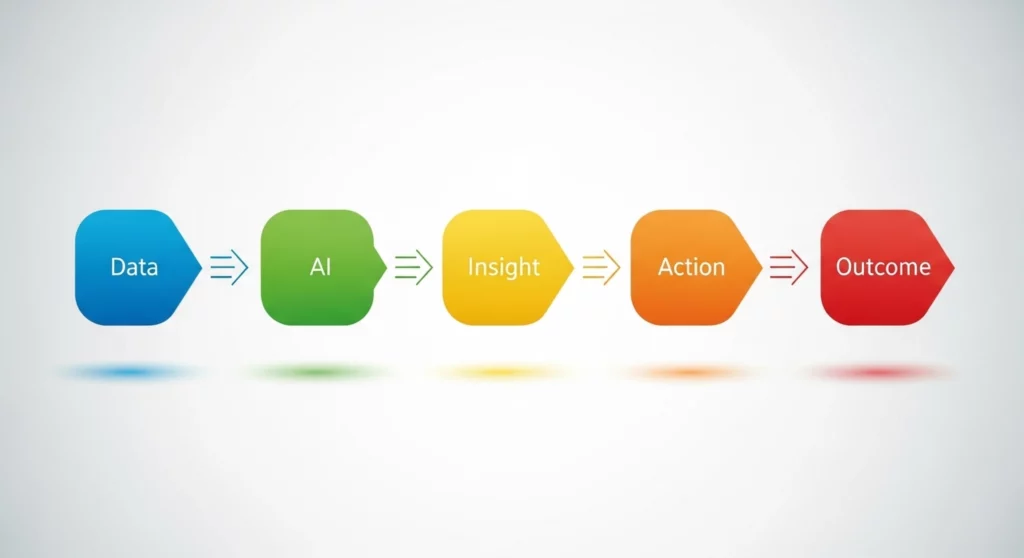The Competitive Edge isn’t AI. It’s How You Use It

Over the last couple of years, the question “Are we already using AI?” has been asked with increasing frequency in boardrooms, conferences, and strategic planning sessions. Executives hear it everywhere: in analyst reports, media headlines or even from their own teams who want to experiment with new tools.
It’s an understandable question, but a misleading one. Because the real transformation does not come from if a company is using AI, but from how it chooses to integrate it.
The illusion of Adoption
In today’s world, adopting AI has never been easier. We have platforms open to everyone, simple plug & play APIs, and new use cases appear on the daily. It’s only natural that so many organizations are rushing to check the AI box and be able to claim “Yes, we are powered by AI”.
But checking a simple box is not a guarantee of value. Too often we see these rushed implementations lead to automating inefficient processes or deploying tools that don’t solve a real problem.
This is the “shiny object” trap. Technology becomes a cost instead of a growth driver. It’s like putting a Formula 1 engine on an old car: it may go fast, but it won’t get far.
The Real Value: The How

By itself, AI is just an impressive technology. But its true power comes from how you choose to integrate it into the fabric of your business. That means it should not be treated as a flashy add-on, but as a quiet, consistent enabler of the things that matter most.
It’s when AI turns raw data into actionable insights that help business leaders make decisions with confidence. It’s when customer experience gets enhanced by a personalized experience that makes your brand feel closer, more relevant and more human. It’s when it automates the repetitive, low-value tasks that often slow down teams, allowing them to focus on making your product even better. And it’s when it accelerates learning across the organization, allowing you to adapt faster than the competition.
This is how we should use AI. Not as a buzzword or a checkbox, but as a strategic advantage that is hard to copy because it’s built into how you work, not just what you use.
Turning Philosophy into Practice
At Creative Coefficient, we believe AI only creates value when it’s directly tied to a business outcome. That’s why we don’t just deploy algorithms, we design solutions that address specific challenges in measurable ways.
In the education sector, we leveraged AI to analyze attendance patterns, combined with academic performance and engagement metrics to anticipate potential student dropouts before they even happened. This allowed educators to respond in a timely manner with
personalized interventions, improving retention rates and giving at-risk students a better chance to succeed.
In social media, we used AI to analyze user behaviour and engagement trends to personalize each user’s feed. By understanding what types of content were most likely to resonate, the system surfaced more relevant posts in real time. This data-driven design boosted session duration, improved interaction rates, and created a more engaging user experience.
These examples show how the competitive edge does not come from the technology itself, but how it’s applied into a specific business context.
Not Everything Needs AI. But Every Company Needs an AI Strategy
It’s tempting to apply AI everywhere. An exciting technology that offers endless possibilities, and the pressure to keep up is real. But the truth is, not everything needs AI. Sometimes the most effective solution is to simplify or redesign a workflow without adding additional
complexity.
However, what every company does need is a clear, intentional AI strategy. One that identifies where it can deliver measurable results, align with business priorities and ensures ethical, responsible use. Without a strategy, AI just becomes a tool that delivers a fragmented
set of experiments rather than a sustained growth driver.
The organizations that will lead in the years to come won’t be the ones that use AI the most. They’ll be the ones that use AI with purpose, embedding it into the right places as a silent, but efficient, helper.
Because, in the end, AI is not the star of the story. You and your team are. Our role is to make sure AI works for you, and not the other way around. And that starts with building the right strategy, together.





